by: Franz Kröger Taken from: https://buluk.de/Buluk10/PublFKRs.htm
The two components of our new main feature, “Cultural Heritage” and “Tourism”, do not seem to have very much in common at first sight. Nevertheless, both are concerned with the highlights of Bulsa culture. Only the viewpoint is different. In the context of “cultural heritage”, we may consider Bulsa customs, ritual and secular events and festivals, historical events with far-reaching consequences and, lastly, outstanding objects of material culture or the fine arts which were handed down by ancestors to the present generation.
A tourist is a stranger who, at best, wants to broaden his or her intellectual horizons by acquiring knowledge of other cultural forms without spending too much time in grasping the inner nature of the culture being visited. They are often interested in exotic and entertaining elements such as dances (in the case of the Bulsa, it would mainly be the war dance), festivals of all kinds, the colourful market life, etc.
When dealing with historical events, the targets of interest are slightly different. While the story of ancestors, the founding of villages, or immigrations from other ethnic groups (e.g. Atuga coming from Mamprusiland) are of great importance to all Bulsa, the tourist is often more interested in acquiring further knowledge of well-known global issues such as colonialism and slavery, which are now connected with corresponding events in the Bulsa area. In order to address both aspects, this magazine has selected individual themes from different areas of Bulsa culture which may be attractive to tourists but can also serve to deepen the knowledge of educated Bulsa especially. These themes include, for example:
1) Historical sites and monuments
The very extraordinary caves and hollow trees used for refuge will certainly be an attraction to tourists who are interested in history, particularly in West Africa’s slave raids.
2) Religion
Ancestor veneration is certainly a central cultural institution regulating more than just religious matters. Through the rotation of ancestral shrines within one lineage, economic and social matters are also regulated within this group. The rotation system, which is very difficult to understand by outsiders, can be exemplified by visiting a compound with a long row of ancestral shrines in front of the entrance.
3) Native music and dance
Performances of native dance and music are a “must” in the expectations of tourists, and they appear prominently in all programs for tourist excursions in West African countries.
In our article, we simply list the common Bulsa dances, as they appear on numerous occasions of Bulsa festive and ritual life.
4) Technologies and products of material culture
Weaving mats and baskets, forming ceramic vessels in the coiled method, forging iron tools or creating brass figurines using lost-wax casting: all these techniques are attractive to tourists and are part of guided tours, similar to those led in other countries.
Out of all the Bulsa objects of material culture, I have only touched on the busik basket here in a separate chapter because of its unique production, shape and usage. One of the preconditions for flourishing tourism in the Bulsa area will be a new Bulsa museum, and it would be there that other aspects of material culture could be explained.1. Historical Sites
In the historical memory of the Bulsa, the battles against the slave raider Babatu, as they took place mainly in Sandema and Kanjaga, play a large role. They give rise to questions like: “Which Bulsa villages participated in these and other battles? How did these battles turn out? Where exactly did they take place? Are there any traces left today?”
Non-Bulsa tourists would probably show less interest in these questions. The exact locations of the battle-grounds are controversial, and even if one considers a certain site to be the very battle-ground, it offers little that makes a long tour to a remote area worthwhile.
This might be changed if the site can offer interesting objects associated with the battle. In Fiisa, near the Azagsuk tanggbain, something like that has already been arranged. Visitors are shown traditional weapons, jewellery and parts of rifles used in the battles by or against the Zabarima. Information about such objects could be conveyed by an expert guide with a good knowledge of English or via a short informational brochure in English.
In this context, for example, stories about the battle south of Sandema could be told to the victors near the Akumcham-sheabutter tree on which the corpse of one of Babatu’s wives was displayed.
The places where Bulsa took refuge from Babatu’s raids may be more interesting for tourists than the battle-grounds. Caverns of refuge are probably scattered over the whole of the Bulsa area, but I know of only three such caverns in Wiaga, which in their plans and construction differ fundamentally from others in Northern Ghana.
Tourist might be shown the well-preserved Posuk Cavern to the south-west of Wiaga. In the time of Babatu, the cavity in the rocks was completely invisible from outside, and people could enter it only through a man-made shaft and a tunnel ending in the natural cave. Here the fugitives, especially old people, women and children, were crammed into this small room (Kröger 2008, p.33). Today the shaft and tunnel are partly blocked by stones and sand, which might be removed before the first visiting tourists appear.
Hollow baobab trees might have offered a smaller refuge for about 5-6 people. One of these trees, situated near Pung Muning Hill (Wiaga), might be visited by tourists, too.
Imparting knowledge about Atuga, the founder of the Atuga-bisa, will involve similar problems. Conjectures about his home and workplace are either controversial or inaccurate. The starting point for an oral introduction might be Atuga-bogluk, the big ancestral shrine at the entrance of Kadema. Here, a guide can tell stories about Atuga’s departure from Nalerigu, the first settlements in Bulsaland and the myths about the foundations of Kadema, Sandema, Wiaga and Siniensi by Atuga’s sons Akam, Asam, Awiag and Asinieng.
2. Ancestral Shrines (bogluta)
Note: For Buli bogluk (pl. bogluta) I prefer the English translation “shrine” because “altar” does not sugget the fact that the supernatural being is staying in the sacrificial stone of the bogluk. “Fetish” has too many negative connotations while “god” is utterly wrong. Ancestors do not become gods after their death, although their wen (see below) is a divine element.
In many West African societies, it is quite difficult for a stranger to acquire a detailed knowledge about a group’s ancestors, their names, their shrines and their significance to their living descendants. It is not unfriendliness when they refuse to answer certain questions, but they do not want to anger their forebears by telling secret details about them to strangers. Even in some Bulsa compounds outside of Wiaga, some compound heads hesitated to inform the inquirer about which ancestor is venerated in which shrine.
Many Bulsa, however, especially those with whom I’m familiar in Wiaga, have a different mentality. Anamogsi, an elder of Wiaga-Badomsa, told me, “The ancestors and tanggbana (earth-shrines) like all people who do not come to them with evil intentions”. In his compound his youngest son incised the names of all important ancestors into their mud shrines, and this makes understanding the ancestral system much easier for visiting strangers.
The connection between ancestors as important and powerful figures of a compound and as spirits that receive sacrifices in shrines will be described in a concise way below. Most strangers will not expect such a complicated system that is based completely on strictly logical premises. It can be regarded as a comprehensive explanation and answer to the frequently asked question: “What is the meaning of these mud constructions in front of the compound”?
The compound head (yeri nyono) will voluntarily tell the visitor that the mud shrines are the residence of the male ancestors of the compound. Their placement is not arbitrary. Rather, they are (or ought to be) in one line with the kpilima dok (ancestors’ room), the main grain store (bui) andthe front entrance (nansiung). All humans should treat these shrines with respect and reverence, but there is no general fear in using the shrines for other secular purposes, e.g. as benches. When I once tried to take some photos of a tigi (secular festival) in front of Anyenangdu Yeri (Wiaga-Badomsa), the yeri-nyono (Anamogsi) invited me to stand on the biggest shrine for a better overview.
To understand the significance and meaning of the ancestral shrines, some further explanations are necessary. It is clear that the line of shrines is arranged according to size: The youngest ancestor has the smallest shrine while the oldest may be so big that sacrifices can only be made when the sacrificer climbs on it. For every ancestral generation there is usually only one shrine, meaning that the oldest ancestor in a line of six shrines lived six generations before the youngest1. There are round quartz stones (tintankoa, sing. tintankori) in the centre of the shrines’ surfaces. It is here where the ancestral wen – the divine component -is located and where it receives sacrifices.
Some of the cylindrical mud constructions have two or more wen-stones. While the line of shrines represents the lineal or vertical genealogical aspect, the additional wen-stones represent the lateral or “brother” relationships to the main shrine inhabitant. These brothers cannot have a shrine of their own because they have no male descendants to sacrifice to them. But as shrine-mates of their brothers, they can take part in the sacrifices offered to the ancestors with male descendants. Or, as an informant put it, “Some of the sacrificed blood will flow from the main to the second stone”.
There may be other attachments in or near the main ancestral shrines: A medicine shrine, which is a ceramic vessel with water and roots, may even receive part of the sacrifice. A piece of iron representing a knife may be imbedded in the surface of the shrine and is supposed to protect the human inhabitants of the compound against any unwelcome intruders. In a Sandema shrine of a male ancestor, I even recognized a knobbed vessel representing the ancestor’s mother2.
The “owner” (nyono) of the line of ancestors, usually the head of the compound, holds a number of titles.
1) He is the sacrificer and official organiser of every sacrifice and will intone the prayers to the ancestor. He also performs sacrifices to the shrines acquired by one of the ancestors, e.g. earth-shrines (tanggbana), medicine-shrines (tiim-bogluta) or shrines of certain bush-spirits (jadok-bogluta).
2) He is the elder (kpagi) of all descendants of the oldest ancestor. On the one hand, as the lineage head, no important action within his lineage (e.g. founding a new compound) may be performed without his permission. On the other hand, the kpagi cannot sell cattle belonging to one of his ancestors without the permission of the ancestor’s other living descendants.
3) He is the owner of all the land and cattle (respectively, their offspring) acquired by one of the ancestors. If a stranger (e.g. a tourist) visits a compound with a long line of big ancestral shrines, he may be sure that the yeri-nyono is not a poor man.
When the head of the compound has died, the inheritance of his ancestral bogluta may be a complicated affair and may even cause inter-lineage conflicts. The rule is that the most senior living male descendant of the most senior generation will be his successor. Usually this descendant is not living in the deceased elder’s compound, which means that the shrines have to be transferred to the successor’s compound3.
After the new owner has died, the bogluk is again transferred to the compound where the then-most senior man of the lineage is living. Over the course of time, the ancestral bogluta may thus rotate through all the houses of the lineage. It should be remembered that not only is the mud-shrine subject to rotation. Also the social position of the kpagi, large areas of land as well as large numbers of cattle are included. The rotational system gives every male member of a lineage the chance to become a very rich man overnight after the death of the hitherto richest man.
European tourists will be impressed hearing about such a system and will probably compare it with European systems of distributing economic commodities after a person’s death.
ENDNOTES (Ancestral Shrines)
1This is not always the yeri-nyono’s father since his shrine may still be in the compound if the final funeral celebrations for him have not been performed yet.
2Usually shrines of ancestresses can be found as vertical stones on a footpath leading to the woman’s parental compound or as a knobbed vessel in the kpilima dok (the ancestors’ room) inside the compound.3It is not the whole mud shrine that is transferred, but only the white sacrificial stones (tintankoa) for which a new mud construction is built in the new compound.
3. Bulsa Dances
When I was impatiently waiting for my first opportunity to visit Bulsaland in 1973, I discovered a photo of a Bulsa war dance group in the Daily Graphic newspaper of January 5, 1973. They were performing their dance at the Fiok festival of Sandema. The photo certainly aroused the attention of the southern Ghanaians, too. One month later, on February 2, 1973, the Daily Mirror published photos of Bulsa performing a war-dance during the Agricultural Show in Zuarungu.
Bulsa dances, especially the war dance, are the hallmark of the Bulsa for outsiders, and they also attract a great deal of attention by non-Bulsa. Demonstrations of dances outside of the Fiok Festival would surely be a tourist attraction within Bulsaland.
Although observers experience these dances and the accompanying music more emotionally as an aesthetic performance, some data on the Bulsa dances will be listed here.
3.1 The War Dance (leelik, pl. leelisa)1
This dance is certainly imitating a bull or buffalo when the dancers step forward very slowly, step backward quickly, stamp their legs on the ground and turn the upper part of their bodies backward while rotating it. Complimenting these dancing movements, the war dancer wears a helmet to which buffalo horns or, more rarely, of a domesticated bull have been attached.
A war dance may have the following rhythmical pattern:
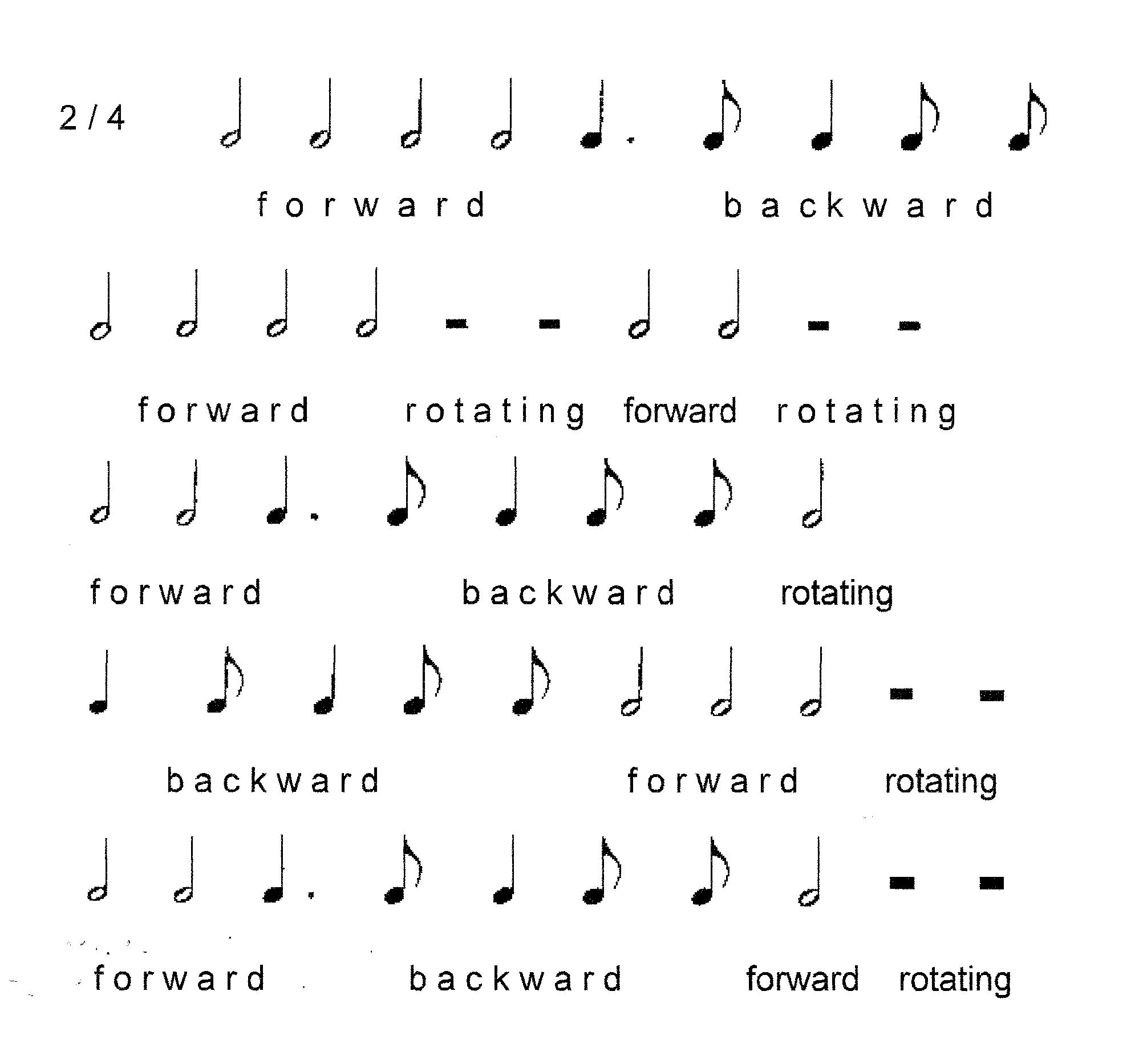
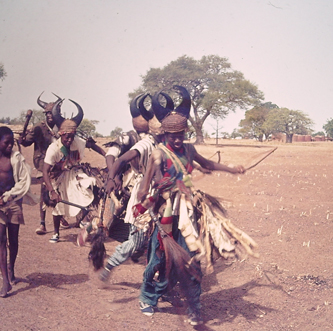 |
| A war dance om Sandema-Kalijiisa 1973 |
We do no know anything about the origin of this dance. For fighting in battles and particularly for hunting, the heavy helmet with the cumbersome horns is not the ideal equipment. By contrast, the calabash cap, which is probably older than the horned helmet, is certainly more suited.
Perhaps the origins of the dance are associated with magical rituals. By adopting the appearance and behaviour of a buffalo, the hunter might obtain power over the dangerous animal.
Among all the traditional Bulsa dances, only the war-dance demands a particular costume, which is similar to that of a hunter’s or warrior’s. The following dresses, arms and decorations can be found among war-dancers:
• a war helmet consisting of a woven skull-cap and the two horns of a buffalo or a domestic bull
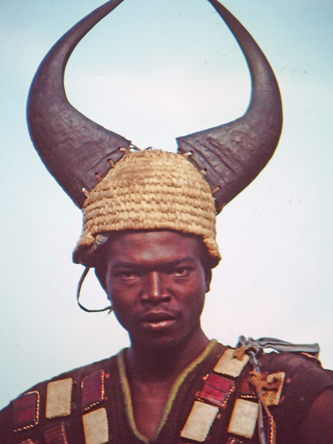 |
| War helmet and saba smock |
• a traditional short smock (garuk), often dyed brown (as camouflage) and often studded with charms embedded in rectangular leather cases (saba). Such a smock is called saba-garuk.
• a tangkalung, a leather or skin apron which is often a goat’s skin
• the traditional kurik-koluk trousers, which today are often replaced by Western trousers, e.g. jeans
• many bangles, among them one (poali) which protects the shooter’s arm from the bow-string
• the arm quiver containing un-poisoned arrows (arrows are poisoned before a hunt or battle)
• the cylindrical or flat wooden quiver at the warrior’s left side with spare arrows. Various objects may be fixed to the quiver: charms in leather cases, fly whisks, hunting trophies, many skins of animals, brass or iron bells (longa) and changsa (iron idiophones, wrongly called finger-bells). I even once saw a living fowl fixed to the quiver of a dancer.
• the footwear may consist of modern sandals. In the past sandals were made from thick elephant skins and somewhat resembled the modern sandals made from car tyres.
• an axe in his right hand. Today they are without iron blades, and the upper part is sometimes shaped like the head of an antelope.
• instead of the axe-handle, a flywhisk may be held in the right hand. It consists of an animal tail (usually horse) and a big leather handle, usually containing charms.
• a bow held by the dancer in his left hand
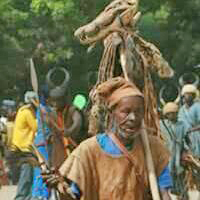 |
| The stick with magical objects and trophies |
Sometimes an old man, holding a stick with various objects fixed to its top, joins the war-dancers. The objects on the stick may in part be trophies as, for example, the crocodile’s head in the photo2or they may in part be magical things that ward off evil from the dancers.
The dancers are unmasked. James Agalic, however, obtained information from older community members confirming that in the past men also danced in a costume called tanjangi (pl. tanjanga), which consisted of big bundles of long grass that hid the face of the dancer. In this disguise, war-dances might also have been performed in the past. In hunting expeditions, the grass might have been a suitable hunting camouflage because it permits the hunter to approach a wild animal without being discovered too soon.
Today the musical instruments accompanying a war-dance may consist of the following, although some of them are not used in every dance;
• the small and middle-sized cylindrical drum (ginggaung-diak and ginggaung chogsung), but never the big drum (ginggaung-nubi)
• the kantain horn-trumpet, though not the similar-looking namuning
• one wooden tapiliok or yui-poliok flute, an instrument that was also used before a hunting tour or a raid. As this type of flute has become rare today, it is usually replaced by a tagalik-flute.
• playing one or two senlengsa double bells is apparently optional.
Today the leelik is danced on only a few occasions such as funerals and big festivals. The Fiok festival in Sandema or the installation of a new chief will include the leelik, for example. When the dancers are invited to big festivals outside the Bulsa area, they will also dance it.
Usually on the second day of the kumsa-funeral, war-dance groups from the deceased man’s section as well as neighbouring sections appear in their full costumes. Before the guest group is allowed to dance, they visit the death mat (ta-pili) of the deceased in the
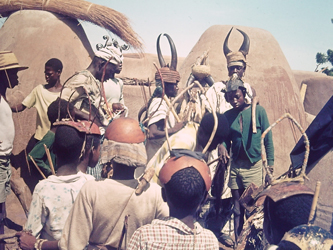 |
| A boys’ group in Sandema Kalijiisa 1973 |
cattle yard of the compound. The dancing-group of the deceased man’s lineage is led by the deceased’s eldest son who dances as the first warrior of the line. Often this group visits the tanggbain of the ritual section. Their own compound may be surrounded by the group before it walks to the original (usually abandoned) settlement (guuk) of the deceased’s ancestor where dances are also performed.
In addition to the dancing groups of adult men, many sections have groups made up of small boys. They do not wear the horned helmets but rather calabash caps often consisting of only a large sherd with two stalks on it representing the horns. Like the adult warriors, they also hold a bow in their left hand and the wooden handle of an axe in their right. Instead of a quiver (or the tankalung leather apron?), they wear a bundle of short millet (or bamboo?) stalks.
These boy-groups are not a parody but are highly respected by the adults. Before starting their dances, they also visit the death mat in the cattle yard. Women are not allowed to dance the leelik, but they may accompany the group of men with a cloth to wipe off the sweat of a dancer when necessary.
3.2 Gokta3
The gokta-dance is perhaps the quickest Bulsa dance and requires a lot of energy from the male or female dancer. It is mere entertainment for the dancers and spectators.
The participants and spectators form a circle, while two drums4are beaten in a relatively simple rhythm. Usually one young man or woman (though on rare occasions, two) jumps into the circle and starts dancing on the spot by raising one knee by turns in a very quick manner. The hands of women dancers are held upwards in rhythmical movements while the hands of a male dancer move at chest height. The dancing steps of women are slightly different from those of men and their knees are not raised as highly.
As the dance is very exhausting, one solo dance rarely takes longer than one or two minutes. Before the dancers rejoin the spectators, they may request another person to dance. Spectators who have a particular affinity for a dancer or his/her dance may press a coin or a banknote on his/her wet forehead.
3.3 Duelingka
This is a striding dance with a complicated rhythm. The dancers are accompanied mainly by drums, most of which are ginggana-cylindrical drums, though there are also calabash-drums (goa, sing. gori), hourglass-drums (gunggona, sing. gunggong) and, very rarely, a pair of basketry rattles (sinyaala or sinsangula) present.
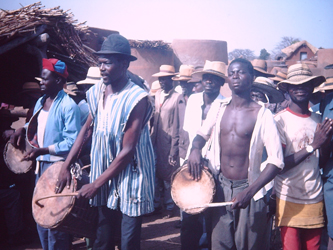 |
| Musicians, elders and mourners surrounding the compound |
If the duelingka-dance is performed by specialized Bulsa dancing groups, it can also be danced in a line or a circle.
3.4. Din-jim
At funerals this dance is performed, when elders, often accompanied by big crowds of mourners and visitors, are surrounding the funeral compound in rather slow steps. The accompanying instruments are similar to those of the duelingka-dance.
3.5 Nagela
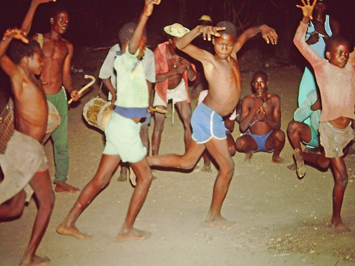 | 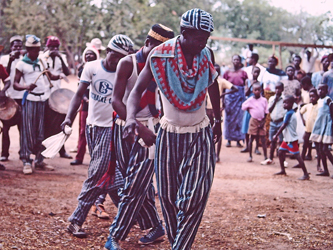 | |
| Nagela-dancers in front of a compound | Nagela-dancers at a big festival |
According to Peter Angaaba Atesiuk, this dance was performed to escort a group of chiefs (na< naab, chief) or elders when they were walking to a meeting, thus summoning a blessing from above (i.e. God)5.
Today the Nagela dance is danced mainly as an entertainment by men and, rarely, by women. The dancers form long rows and, similarly to the war dances, move forward and backward. Their arms are thrust up, and they often hold animal tails or bunches of leaves in their hands. According to Angaaba, throwing up their hand is called “chogsi chingmarika [or], chogsi gambani” (i.e. ‘catching the star’ or ‘catching the sky’). By these movements the blessing from above is invoked.
There may be different musical instruments accompanying the dancers: 2-3 cylindrical drums, alternatively 2-3 calabash drums (goa or goe), 2-3 or more flutes (yuisa), or alternatively 2-3 horn trumpets (namunsa).3.5 Small ritual dances
Some ritual dances of short duration will probably never be performed before tourists’ eyes but should be mentioned here to complete the list.
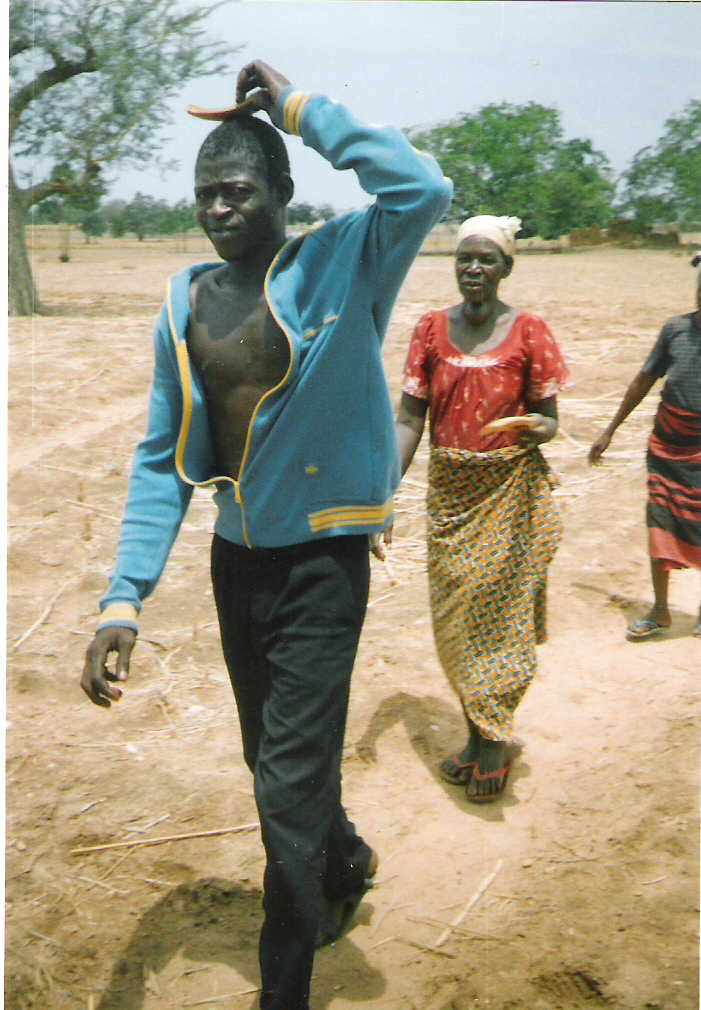 |
| Young man dancing the senlengsa-dance |
• Afterthe ceramic and calabash vessels of a deceased wife have been ritually destroyed in the second funeral (juka), the women who performed this ritual act dance the senlengsa-dance on the sherds. While dancing they balance one potsherd on their heads. They are accompanied only by the double-bell (senlengsa). On rare occasions, men may join this dance (see photo).
• The following ritual dance can only be performed at nighttime. When a new soothsayer (baano) is initiated into his new office by an old and experienced soothsayer, his fellow soothsayers from the same section assist him by performing a dance around the neophyte who is inhaling the smoke from burning, half-charred medicine. While dancing with their rattles in their right hands, they sing:
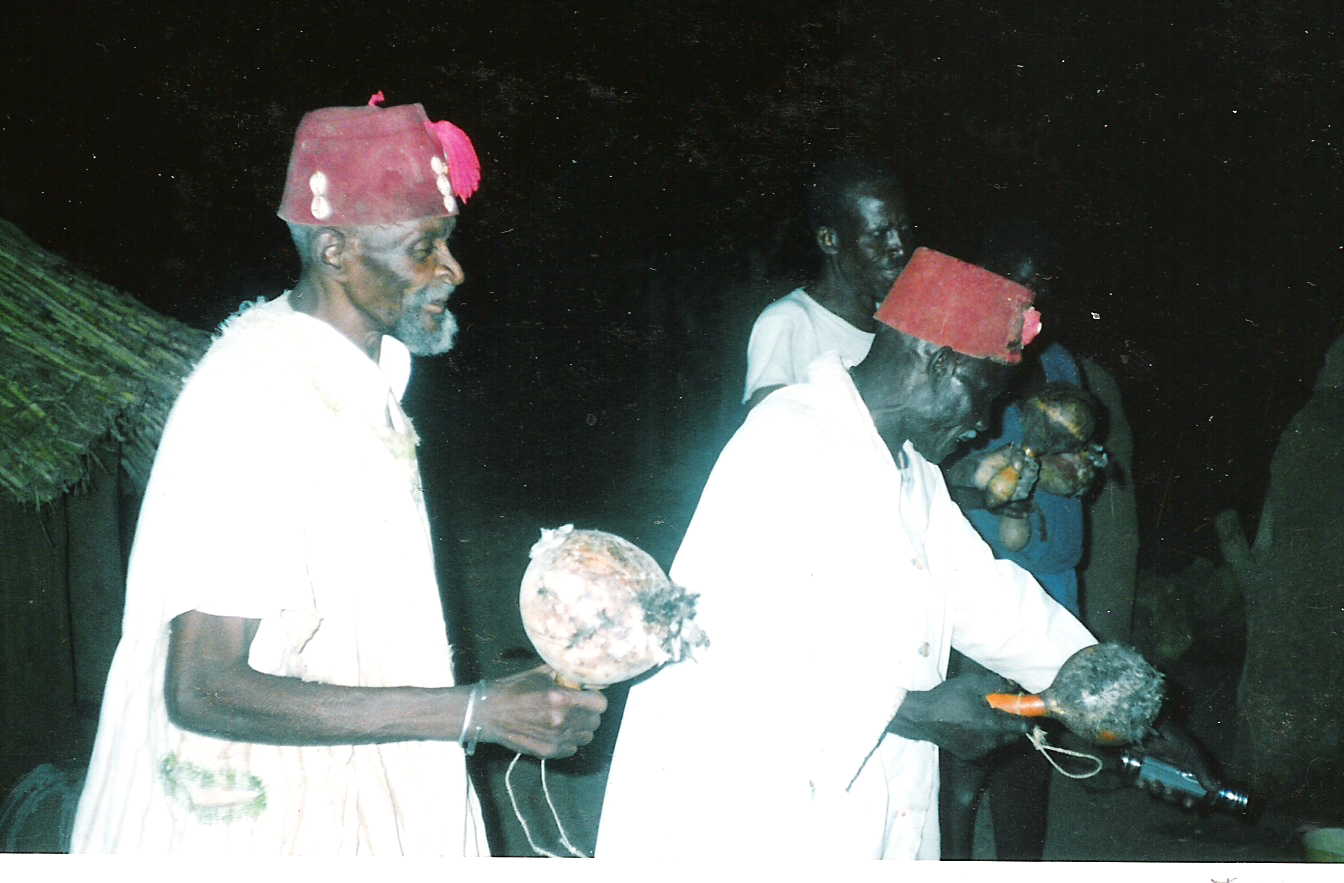 |
| Soothsayers dancing during an ordination (Sinyangsa-Goldem) |
Baano a chabli tiimu. – Nipok a chabli tiimu.
(A soothsayer is inhaling the medicine. – A woman is inhaling the medicine)
Before they stop their dance, each of the dancers strikes the head of the then-unconscious neophyte with his rattle.
• A short dance is performed after the birth of a baby by the midwife and her assistants on the spot where the placenta of the new born baby has been buried.3.6 Occasional Dances
All Bulsa, young and old, male and female, like dancing. It is not only the ritual dances and the dances for entertainment that they enjoy. Whenever there is an occasion or they hear rhythmical patterns, they may perform solo-dances.
When two women with naked breasts are tired of grinding shea nut butter, they dance the so-called buluk-sangula6–dance. They beat their naked arms in a particular rhythm against their hips so that a peculiar sound is generated in their arm-pits (bulukta, sing. buluk).3.7 Innovative Dances
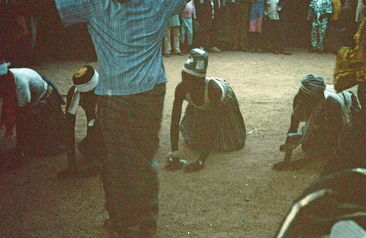 |
| Koku-lag-siuk-te n taam |
• In addition to the traditional standard dances, semi-professional Bulsa dancing groups perform dances which can often be recognized as non-traditional by their names (e.g.): Paati-paati-paapa (paati: Engl. ‘party’, paapa: Twi ‘good’). The original song on which the dance is based was popularized in Africa and other parts of the world by the South-African singer Miriam Makeba and is usually known by its name Pata-pata.
• Another new and popular dance is called “Koku-lag-siuk-te n taam” (The Ghost Opens the Way that I Can Pass). In 1988 it belonged to the standard dances of the Badomsa dancing group.
ENDNOTES (Dances)
1A more detailed description of the dance can be found in Kröger 2001: 640-41, of the use of musical instruments ibd. p. 732.
2Source of the photo: Ka-wenboka Hutchinson in the Facebook group Buluk Kaniak, November 9, 2017. Photo: the late Baba Adiivum from Fiisa with his trophies and charms.3Gokta can also be a general term for all dances, cf. gogi, to dance.4According to James Agalic (via oral communication), in the past, 2-3 calabash-idiophones were used instead of the drums.
5Post in the Facebook group “Buluk Kaniak” (July 5, 2017). Angaaba associates the syllable ge with Buli geb, whose basic meaning is “to cut”, but is allegedly used here with the meaning of “to guide”.6Sangula means a basket-like rattle. At least today, no rattle is beaten to accompany this dance.
